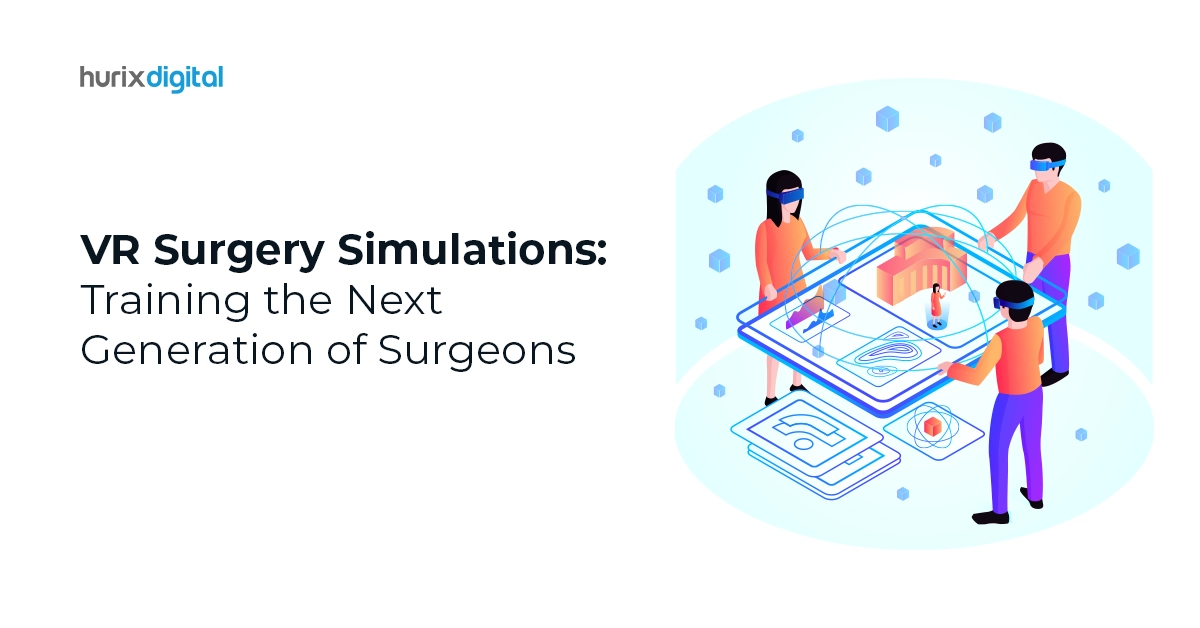
VR Surgery Simulations: Training the Next Generation of Surgeons
Summary
This article discusses how VR surgery simulations are training the next generation of surgeons. It highlights the benefits of virtual reality in providing realistic, hands-on practice, improving surgical skills, and enhancing learning outcomes.
When it comes to revolutionizing surgical education, VR Surgery Simulations lead the way. They not only offer immersive experiences but also transform the training of the next generation of surgeons.
VR in medical education offers transformative experiences that break the limitations of traditional training methods and ensure hands-on learning in a safe, risk-free environment.
By providing realistic scenarios and interactive procedures, VR technology enhances understanding and skill development, preparing surgeons for real-world challenges with confidence and precision.
In this blog, we’ll explore how virtual reality surgery simulations are revolutionizing the way we train the next generation of surgeons. We’ll also explore the challenges, components, and more. Read on!
Table of Contents:
- The Immersive Experience of VR Surgical Training
- Components of VR Surgery Simulations
- Advantages of VR in Surgical Education
- Strategies for Successful Implementation
- Future Directions and Innovations in VR Surgical Training
- Final Words
The Immersive Experience of VR Surgical Training
Immersive surgical training through virtual reality surgery simulations provides a truly interactive experience for trainee surgeons.
By replicating realistic anatomy and offering interactive procedures, VR technology creates a dynamic learning environment that engages and challenges learners. Real-time feedback mechanisms further enhance the learning process, allowing for continuous improvements.
In traditional training, surgeons often rely on textbooks and cadaveric practice, which can limit hands-on experience.
On the other hand, virtual reality surgery simulations revolutionize learning by offering an interactive and immersive approach. Surgeons can engage in realistic surgical scenarios, enhancing their skills in a safe environment without consequence.
Also Read: Healthcare Access for All: Navigating USA’s Digital Accessibility Standards
Components of VR Surgery Simulations
Here are the major components of VR Surgery Simulations:
1. Realistic Anatomy Replication
Virtual reality surgery simulations replicate human anatomy with precision, allowing surgeons to practice procedures on virtual patients. This realistic representation helps surgeons understand the intricacies of the human body, improving their skills and knowledge.
2. Interactive Surgical Procedures
Through VR technology, surgeons can actively participate in simulated surgeries, performing tasks and making decisions as they would in a real operating room. This interactive approach enhances the hands-on learning experience.
3. Immediate Feedback
VR in medical education offers instant feedback on surgeons’ performance, allowing them to assess their skills in real time. This immediate feedback enables continuous improvement, as surgeons can identify areas for enhancement and refine their techniques efficiently.
Advantages of VR in Surgical Education
Next-generation surgeon training is revolutionized by the immersive and interactive nature of VR simulations.
Here are the major advantages:
1. Overcoming Traditional Limitations
VR offers access to diverse surgical scenarios, preparing trainees for real-world challenges they may not encounter during traditional training. Also, it offers a safe environment for making mistakes and learning from them without serious consequences.
2. Accelerated Learning and Skill Acquisition
With case-based learning and practice in virtual environments, trainees can accelerate their learning and skill acquisition. They can repeat procedures multiple times, refining their techniques and gaining confidence in their abilities more quickly than with traditional methods. This accelerated learning can lead to more competent surgeons in a shorter amount of time.
3. Shaping the Skillset of Next-Generation Surgeons
Virtual reality in healthcare training provides a platform for aspiring surgeons to enhance their knowledge and expertise in a realistic and risk-free environment. It promotes collaboration and knowledge sharing among surgeons, creating a supportive community where experiences and insights can be exchanged.
4. Meeting the Challenges of Modern Healthcare
VR in medical education offers a scalable and accessible platform for training, helping to bridge the gap between demand and supply in the healthcare industry.
By offering high-quality training experiences, VR technology breaks down geographical barriers, allowing aspiring surgeons from around the world to access standardized and top-tier training programs.
5. Overcoming Barriers to Adoption
Ensuring access to suitable hardware, software, and technical support is crucial for the seamless integration of VR in medical education into educational programs.
Aligning VR experiences with traditional teaching methods and learning objectives enhances the educational value and relevance of virtual reality surgery simulations.
Strategies for Successful Implementation
Below are the top strategies you can follow to ensure successful implementation of VR surgery simulations:
1. Faculty Training and Support
Providing faculty members with adequate training and support in utilizing VR technology is essential for effectively incorporating immersive surgical training into their teaching methodologies.
2. Gradual Integration
The incremental incorporation of virtual reality surgery simulations into training programs allows for a smooth transition and adaptation to this innovative technology. This will help students and faculty members become familiar with the VR environment at a comfortable pace, minimizing overwhelm and maximizing learning outcomes.
3. Customizing VR Simulations to Specialized Surgical Fields
Tailoring VR experiences to specialized surgical fields allows for targeted training that addresses the unique challenges and procedures within each discipline. This customization enhances the relevance and effectiveness of virtual reality surgery simulations, ensuring that trainees receive specialized training tailored to their future practice areas.
Future Directions and Innovations in VR Surgical Training
The future of virtual reality surgery simulations holds exciting possibilities for further advancements in simulation technology.
Here’s what the future might hold:
1. Pushing the Boundaries of Simulation Technology
Here’s how the future of virtual reality surgery simulations holds exciting possibilities for further advancements in simulation technology:
- Haptic Feedback Integration: Allowing trainees to feel realistic tactile sensations during simulations, enhancing the immersive experience and improving muscle memory.
- Artificial Intelligence in Performance Evaluation: Integrating AI for performance evaluation can provide real-time feedback, track progress, and personalize training, making the learning process more efficient and effective.
2. Customizing VR Simulations to Specialized Surgical Fields
Tailored VR experiences for these specialized fields offer trainees the opportunity to practice intricate procedures specific to each field, enhancing their skills and confidence in a risk-free environment.
Additionally, the integration of VR technology into surgical training programs opens avenues for remote learning and collaboration, enabling trainees from across the globe to participate in interactive sessions and learn from experts without geographical constraints.
Moreover, advancements in VR hardware and software will likely lead to more affordable and accessible training solutions, democratizing access to high-quality surgical education worldwide.
3. Collaboration Across Disciplines For Holistic Training Solutions
Bringing together experts from various fields, such as technology, medicine, and education, to develop comprehensive training programs. This interdisciplinary approach ensures trainees receive a well-rounded education that prepares them for the diverse demands of surgical practice.
Also Read: The Future of Training: How eLearning is Revolutionizing Healthcare Education
Final Words
Virtual reality surgery simulations represent a groundbreaking approach to surgical education that is shaping the future of healthcare training.
By leveraging the immersive experience of VR technology, we can enhance the skills and knowledge of next-generation surgeons, meet the challenges of modern healthcare, and promote collaboration across disciplines.
At Hurix Digital, we’re committed to driving this change. With our innovative digital learning solutions, we’re dedicated to leveraging technology to enhance learning experiences, making education more interactive and practical across various industries, including healthcare training.
Connect with our team for more info!

Senior Vice President
A Business Development professional with >20 years of experience with strong capability to sell new solutions and develop new markets from scratch. New Market Entry Specialist with experience of working in two of the largest emerging markets – China & India. Also covered other key markets in APAC, US, EU & ME. Exceptional experience of conceptualizing, ideating and selling new learning technologies like VR AR, etc. across multiple industry verticals.







